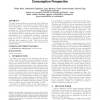Free Online Productivity Tools
i2Speak
i2Symbol
i2OCR
iTex2Img
iWeb2Print
iWeb2Shot
i2Type
iPdf2Split
iPdf2Merge
i2Bopomofo
i2Arabic
i2Style
i2Image
i2PDF
iLatex2Rtf
Sci2ools
114
click to vote
ISLPED
2010
ACM
2010
ACM
STM versus lock-based systems: an energy consumption perspective
The shift towards multicore processors and the well-known drawbacks imposed by lock-based synchronization have forced researchers to devise new alternatives for building concurrent software, of which transactional memory is a promising one. This work presents a comprehensive study on the energy consumption of a state-of-the-art STM (Software Transactional Memory) implementation using STAMP, a representative set of transactional workloads, comparing it to its lock-based counterpart. Our results show that STM can be up to 22x (∼3x on average) more energyinefficient when compared to locks. This work is a novel step towards a better understanding of the energy behavior of STM systems. Categories and Subject Descriptors C.4 [Performance Of Systems]: Design studies General Terms Design, Performance
Hardware | ISLPED 2010 | Software Transactional Memory | Studies General Terms | Transactional Memory |
| Added | 28 Jan 2011 |
| Updated | 28 Jan 2011 |
| Type | Journal |
| Year | 2010 |
| Where | ISLPED |
| Authors | Felipe Klein, Alexandro Baldassin, Joao Moreira, Paulo Centoducatte, Sandro Rigo, Rodolfo Azevedo |
Comments (0)

